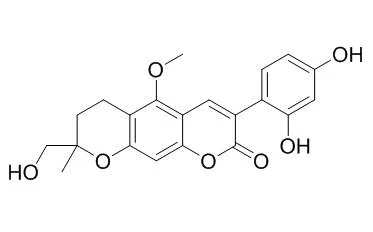| Kinase Assay: |
| Eur J Pharm Sci. 2017 Nov 15;109:472-479. | | The prenylated phenolic natural product isoglycycoumarin is a highly selective probe for human cytochrome P450 2A6.[Pubmed: 28867491 ] | Prenylated phenolic compounds are an important class of bioactive natural products. One major in vivo metabolic pathway of these compounds is hydroxylation at terminal methyl of the isoprenyl group.
This study aims to identify the P450 isozyme catalyzing this metabolic reaction.
METHODS AND RESULTS:
In human liver microsomes, 16 out of 24 screened compounds could be metabolized into their hydroxylated derivatives. Chemical inhibition assays using 11 isozyme specific inhibitors indicated the hydroxylation reactions of 12 compounds were primarily catalyzed by cytochrome P450 2A6 (CYP2A6). In particular, CYP2A6 was the major enzyme participating in the metabolism of isoglycycoumarin (IGCM). The product of IGCM was obtained and identified as Licopyranocoumarin (4″-hydroxyl isoglycycoumarin) using NMR spectroscopic analysis. The Km values for human liver microsomes and recombinant human CYP2A6 were 7.98 and 10.14μM, respectively. According to molecular docking analysis, the catalytic mechanism may involve cyclized isoprenyl group of IGCM entering the active cavity of CYP2A6.
CONCLUSIONS:
These results demonstrate that IGCM could serve as an ideal isozyme selective probe to evaluate CYP2A6 activities. | | Biol Pharm Bull. 2008 May;31(5):838-46. | | Blockade of the dioxin pathway by herbal medicine Formula Bupleuri Minor: identification of active entities for suppression of AhR activation.[Pubmed: 18451504] | Environmental pollutants including dioxins activate the aryl hydrocarbon receptor (AhR) and cause a wide range of pathologies. Development of AhR antagonists will be useful for prevention and treatment of the diseases related to AhR activation. Towards this goal, we aimed at seeking for potential AhR antagonists in herbal medicines using the dioxin responsive element-based sensing via secreted alkaline phosphatase (DRESSA).
METHODS AND RESULTS:
Through initial rough screening, 4 formulae were selected from 20 herbal medicines and subjected to the second, detailed screening. We found that only Formula bupleuri minor (TJ-9) significantly inhibited activation of AhR by 2,3,7,8-tetrachlorodibenzo-p-dioxin. Among 7 raw herb extracts in TJ-9, Glycyrrhizae Radix and Scutellariae Radix were responsible for the antagonistic effect of TJ-9 against dioxin. Some constituents including Bupleuri Radix and Zingiberis Rhizoma rather activated AhR.
CONCLUSIONS:
Among 12 major constituents of Glycyrrhizae Radix and Scutellariae Radix, we identified that Licopyranocoumarin, glycyrrhizic acid and genistein in Glycyrrhizae Radix and baicalein, wogonin and daidzein in Scutellariae Radix had substantial antagonistic effects on AhR. Among these, baicalein most effectively blocked activation of AhR triggered by cigarette smoke, a strong activator of AhR. The antagonistic substances identified here may be useful for prevention from diseases associated with aberrant activation of AhR. |
|






 Cell. 2018 Jan 11;172(1-2):249-261.e12. doi: 10.1016/j.cell.2017.12.019.IF=36.216(2019)
Cell. 2018 Jan 11;172(1-2):249-261.e12. doi: 10.1016/j.cell.2017.12.019.IF=36.216(2019) Cell Metab. 2020 Mar 3;31(3):534-548.e5. doi: 10.1016/j.cmet.2020.01.002.IF=22.415(2019)
Cell Metab. 2020 Mar 3;31(3):534-548.e5. doi: 10.1016/j.cmet.2020.01.002.IF=22.415(2019) Mol Cell. 2017 Nov 16;68(4):673-685.e6. doi: 10.1016/j.molcel.2017.10.022.IF=14.548(2019)
Mol Cell. 2017 Nov 16;68(4):673-685.e6. doi: 10.1016/j.molcel.2017.10.022.IF=14.548(2019)